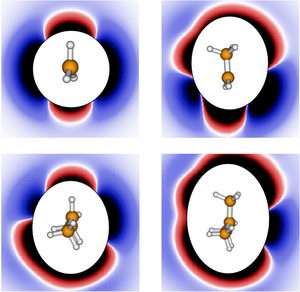High-performance computing aids calculations of combustion kinetics

Even though combustion provides 85 percent of the energy humans use, little is known about many of its most basic chemical reactions. Researchers in Argonne's Chemistry Division have brought together advances in theoretical chemical kinetics and high-performance computing to speed research in the chemistry of fuel combustion.
The chemists developed a new approach to predict the rates of chemical reactions that greatly increases efficiency while maintaining accuracy, cutting costs and allowing research to expand to larger molecules.
"Our research goal," said senior chemist Larry Harding, "is to provide data for the development of accurate models of combustion chemistry to be used in the design of more efficient or cleaner-burning combustion devices. We want to understand in detail the kinetics of each of the individual reactions key to combustion chemistry."
These chemists are performing basic chemistry research on radical-radical reactions relevant to the combustion of hydrocarbons. Radicals are unstable molecules with at least one unpaired electron. The advances in predicting reaction rates will also improve research in atmospheric and interstellar chemistry, including global warming and ozone issues. More accurate rate constants for the individual reactions will lead to better predictions.
Accurate experimental measurements of these reaction rates are challenging because the radicals are difficult to produce in the laboratory. Consequently only a small number of radical-radical reactions rates have been measured accurately. Previous theoretical methods required long computer simulations and could only be applied to small radicals.
"We can now calculate the rates for reactions of interest to us within days to a week, compared to six months to a year previously," said senior chemist Stephen Klippenstein. The research findings appeared in the report, "Predictive Theory for the Combination Kinetics of Two Alkyl Radicals" published in the March 14 issue of Physical Chemistry Chemical Physics (8, 1133-1147).
"The new technique couples efficient quantum chemistry and reaction rate theory with large-scale parallel computing," said Harding. The team of three chemists – including postdoctoral researcher Yuri Georgievskii – adapted a fast but less accurate method for calculating the needed radical-radical interaction potentials with a simple correction to efficiently obtain accurate results.
For the past decade, Harding and Klippenstein split the work into two parts. Klippenstein would generate a thousand geometries of importance. Harding plugged them into his computer codes and calculated the energy for each geometry. They would work back and forth until they had enough data.
"The whole process would take months of computer time as well as months of our own time just correlating things and taking care of all the bookkeeping," Klippenstein said.
"Now that is all automated," Harding explained, "and we also have this more efficient way of doing the electronic structure calculations. Calculating the energy for one geometry used to take us an hour or two; now it takes about a minute."
Harding explains "the new method has been successfully applied to both self- (methyl plus methyl) and cross-combinations (methyl plus ethyl) of methyl, ethyl, iso-propyl and tert-butyl radicals, answering a long-standing debate about temperature dependence. The reaction rates decrease with increasing temperature."
This finding is opposite of expected behavior because most reactions speed up as temperature increases. Before this, many chemists believed that the rates of combination reactions were independent of temperature or that there were small positive temperature dependencies, Klippenstein explained.
This new understanding of the temperature dependence is critical because in the past most of the measurements have been performed at room temperature. "Since we are studying combustion at 1,000 to 2,000 Kelvin, large-scale extrapolations were needed," said Klippenstein.
The new approach also:
-- Validated the geometric mean rule postulated in the 1960s. The geometric mean rule states that the rate of a cross-combination, such as methyl plus ethyl, is twice the square root of the product of the two corresponding self-combinations, methyl plus methyl and ethyl plus ethyl. "This appears to be reliable in relating the rates of cross reactions to rates of corresponding self reactions," said Klippenstein.
-- Demonstrated that the effect of methyl substituents adjacent to the radical site follows a simple rule – each additional substituent slows the reaction by a factor of two. For example, the reaction of methyl (CH3) with ethyl (C2H5) is twice as fast as methyl with iso-propyl (i-C3H7), which has one more methyl group.
The researchers are moving on to new territory. The chemists have so far only looked at hydrocarbon radicals; they now want to investigate oxygenated radicals since combustion occurs in the presence of oxygen.
Another topic to be addressed in the near future is resonance-stabilized radicals. "These radicals tend to be more stable than the other radicals and as a result are present at higher concentration in flames," said Harding.
The resonance-stabilized radicals are key to understanding the formation of pollutants such as polycyclic aromatic hydrocarbons and soot. They also have multiple reactive sites, while those they have studied up to now have only a single reactive site.
Source: Argonne National Laboratory




















